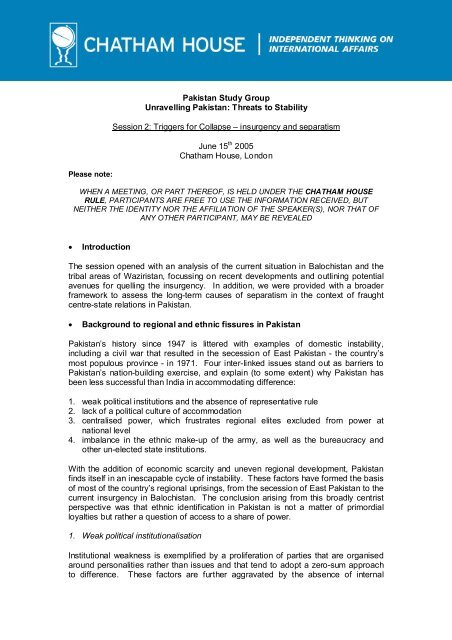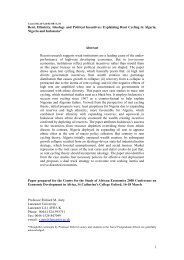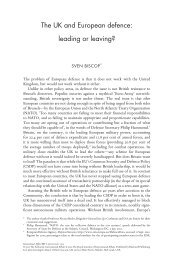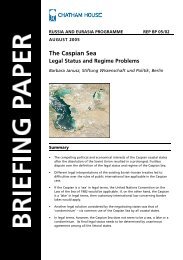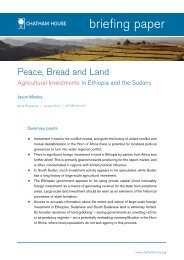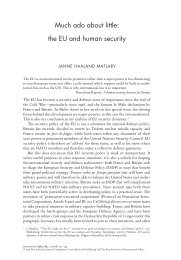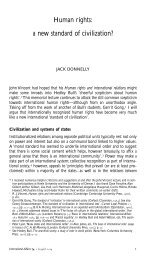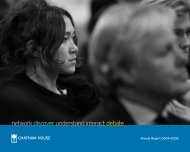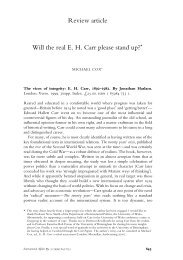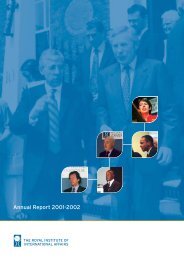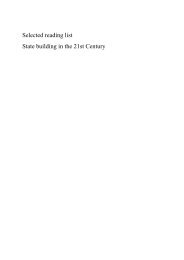A meeting summary is available here - Chatham House
A meeting summary is available here - Chatham House
A meeting summary is available here - Chatham House
Create successful ePaper yourself
Turn your PDF publications into a flip-book with our unique Google optimized e-Paper software.
Please note:<br />
Pak<strong>is</strong>tan Study Group<br />
Unravelling Pak<strong>is</strong>tan: Threats to Stability<br />
Session 2: Triggers for Collapse – insurgency and separat<strong>is</strong>m<br />
June 15 th 2005<br />
<strong>Chatham</strong> <strong>House</strong>, London<br />
WHEN A MEETING, OR PART THEREOF, IS HELD UNDER THE CHATHAM HOUSE<br />
RULE, PARTICIPANTS ARE FREE TO USE THE INFORMATION RECEIVED, BUT<br />
NEITHER THE IDENTITY NOR THE AFFILIATION OF THE SPEAKER(S), NOR THAT OF<br />
ANY OTHER PARTICIPANT, MAY BE REVEALED<br />
• Introduction<br />
The session opened with an analys<strong>is</strong> of the current situation in Baloch<strong>is</strong>tan and the<br />
tribal areas of Wazir<strong>is</strong>tan, focussing on recent developments and outlining potential<br />
avenues for quelling the insurgency. In addition, we were provided with a broader<br />
framework to assess the long-term causes of separat<strong>is</strong>m in the context of fraught<br />
centre-state relations in Pak<strong>is</strong>tan.<br />
• Background to regional and ethnic f<strong>is</strong>sures in Pak<strong>is</strong>tan<br />
Pak<strong>is</strong>tan’s h<strong>is</strong>tory since 1947 <strong>is</strong> littered with examples of domestic instability,<br />
including a civil war that resulted in the secession of East Pak<strong>is</strong>tan - the country’s<br />
most populous province - in 1971. Four inter-linked <strong>is</strong>sues stand out as barriers to<br />
Pak<strong>is</strong>tan’s nation-building exerc<strong>is</strong>e, and explain (to some extent) why Pak<strong>is</strong>tan has<br />
been less successful than India in accommodating difference:<br />
1. weak political institutions and the absence of representative rule<br />
2. lack of a political culture of accommodation<br />
3. central<strong>is</strong>ed power, which frustrates regional elites excluded from power at<br />
national level<br />
4. imbalance in the ethnic make-up of the army, as well as the bureaucracy and<br />
other un-elected state institutions.<br />
With the addition of economic scarcity and uneven regional development, Pak<strong>is</strong>tan<br />
finds itself in an inescapable cycle of instability. These factors have formed the bas<strong>is</strong><br />
of most of the country’s regional upr<strong>is</strong>ings, from the secession of East Pak<strong>is</strong>tan to the<br />
current insurgency in Baloch<strong>is</strong>tan. The conclusion ar<strong>is</strong>ing from th<strong>is</strong> broadly centr<strong>is</strong>t<br />
perspective was that ethnic identification in Pak<strong>is</strong>tan <strong>is</strong> not a matter of primordial<br />
loyalties but rather a question of access to a share of power.<br />
1. Weak political institutional<strong>is</strong>ation<br />
Institutional weakness <strong>is</strong> exemplified by a proliferation of parties that are organ<strong>is</strong>ed<br />
around personalities rather than <strong>is</strong>sues and that tend to adopt a zero-sum approach<br />
to difference. These factors are further aggravated by the absence of internal
democracy, corruption, factional<strong>is</strong>m, and the pers<strong>is</strong>tence of clientel<strong>is</strong>m. Their roots in<br />
Pak<strong>is</strong>tan lie in an underdeveloped civil society, which itself grew out of the colonial<br />
inheritance and prolonged periods of post-independence authoritarian rule.<br />
Colonial admin<strong>is</strong>tration bolstered the traditional leaders of rural society, such as the<br />
sardars (tribal chiefs), the Khans (landed tribal leader) of Baloch<strong>is</strong>tan and the NWFP,<br />
the waderos (major landowners) of Sind, and the feudal lords and pirs (spiritual<br />
masters) of the Punjab. The Brit<strong>is</strong>h admin<strong>is</strong>trators devolved a great deal of<br />
admin<strong>is</strong>trative power to these leaders, but th<strong>is</strong> did not involve political representation.<br />
The Muslim League, t<strong>here</strong>fore, had to accommodate these leaders in order to gain<br />
support in the run-up to independence. Th<strong>is</strong> meant that unlike the Congress Party in<br />
India, it was unable to establ<strong>is</strong>h a mass base at a grassroots level, or develop a<br />
Pak<strong>is</strong>tan-wide sense of identity that could override regional lingu<strong>is</strong>tic and ethnic<br />
differences. Consequently, attention was directed away from constructing political<br />
bodies, and towards military and bureaucratic instruments for admin<strong>is</strong>tering control.<br />
2. Absence of Political Accommodation<br />
Powerholders in Pak<strong>is</strong>tan have cons<strong>is</strong>tently failed to accept the legitimacy of<br />
opposition. The roots of th<strong>is</strong> weakness can be found before independence, when the<br />
colonial admin<strong>is</strong>tration operated under a policy of ‘divide and rule’, playing off groups<br />
and communities against each other and strengthening local leaders in areas that<br />
had no political representation at all. The shift from th<strong>is</strong> system to the formation of a<br />
nation-state was not smooth, and in fact, the policy has to some extent continued in a<br />
different gu<strong>is</strong>e. In addition, the impact of a feudal class contributed to an emphas<strong>is</strong><br />
on tribal and kin loyalty at a local level. Furthermore, though the middle class has<br />
been growing for some years now, t<strong>here</strong> has been no development of middle class<br />
political parties. A final factor <strong>is</strong> the underdevelopment of civil society (another<br />
legacy of the colonial era), which has hindered the articulation and aggregation of<br />
interests.<br />
The consequences of weak political institutions are that they create the conditions for<br />
chaos, which can then be used as a justification for military coups. Th<strong>is</strong> has allowed<br />
the army to seize control by claiming that its intervention was necessary to maintain<br />
stability. However, prolonged authoritarian rule only serves to undermine the political<br />
institutions further, thus becoming a causal factor of the fragility.<br />
3. Central<strong>is</strong>ation<br />
The Pak<strong>is</strong>tan movement was prem<strong>is</strong>ed on the fear of central<strong>is</strong>ed rule by a Hindudominated<br />
Congress. Once Pak<strong>is</strong>tan was created, however, the Muslim League<br />
pursued its own central<strong>is</strong>ed rule in the name of nation building. Provincial<strong>is</strong>t<br />
sentiments and loyalties were seen as a barrier to the latter. Since then, the centre<br />
has continually rejected demands for increased provincial autonomy throughout<br />
Pak<strong>is</strong>tan’s h<strong>is</strong>tory. Central<strong>is</strong>ation reached its peak in 1956 with the introduction of<br />
the ‘One Unit’ scheme, which establ<strong>is</strong>hed parity between East and West Pak<strong>is</strong>tan. It<br />
was hotly contested as an attempt to restrict Bengali representation in national<br />
politics and also fuelled anger in smaller provinces like Baloch<strong>is</strong>tan, w<strong>here</strong> ensuing<br />
tension formed part of the reason for the 1958 coup.<br />
4. Ethnic imbalance<br />
The real and perceived domination of Punjab<strong>is</strong> in the army and bureaucracy has<br />
fuelled a great deal of frustration amongst Pak<strong>is</strong>tan’s smaller provinces and ethnic<br />
groups. The state <strong>is</strong> commonly perceived by Baloch national<strong>is</strong>ts (and previously by
Bengali national<strong>is</strong>ts) as ex<strong>is</strong>ting to maintain the strength of Punjab<strong>is</strong>. The<br />
preponderance of Punjab<strong>is</strong> in the army <strong>is</strong> a consequence of colonial practice – the<br />
Brit<strong>is</strong>h army specifically recruited them from the 1880s onwards. It <strong>is</strong> unsurpr<strong>is</strong>ing<br />
that anti-Punjab sentiment <strong>is</strong> more commonplace in times of military rule.<br />
Furthermore, due to the higher education levels of Punjab<strong>is</strong> in relation to Pashtuns<br />
and Balochs, they were found in large numbers within the Indian Civil Service, which<br />
later became the backbone of the civil bureaucracy in India and Pak<strong>is</strong>tan.<br />
It must be noted however that Punjab and the Punjabi community are not<br />
homogenous or monolithic, nor <strong>is</strong> the extent of their domination as pronounced as<br />
some analysts have suggested. To demonstrate th<strong>is</strong> heterogeneity, some<br />
participants at the session suggested that Punjab could quite easily be divided into<br />
three d<strong>is</strong>tinct parts with headquarters in Multan, Rawalpindi, and Lahore. Its<br />
advantage would be not only to correct the perceived imbalance in power but also to<br />
garner support among regions that have fallen behind the rest of the province.<br />
However it was recogn<strong>is</strong>ed that, in reality, tinkering with admin<strong>is</strong>trative units could<br />
serve to create new claims for representation and increase the number of local power<br />
bases. Nevertheless, it was worth considering if only to combat the notion of a<br />
‘monolithic Punjab’.<br />
• Background to provincial grievances in Baloch<strong>is</strong>tan<br />
The Khan of Kalat handed over to the Brit<strong>is</strong>h the areas that were to form the Political<br />
Agency in 1876, for strategic reasons. Unlike the NWFP, Brit<strong>is</strong>h Baloch<strong>is</strong>tan did not<br />
make the transition from a Chief Comm<strong>is</strong>sioner’s to a Governor’s Province. Instead,<br />
the Brit<strong>is</strong>h formal<strong>is</strong>ed the powers of the tribal jirgas (councils), which bolstered the<br />
position of the sardars (tribal chiefs). Economic development in the northern<br />
Baloch<strong>is</strong>tan regions was stimulated by the construction of roads and railways, which<br />
linked the Zhob d<strong>is</strong>trict with Punjab from 1895 onwards. The emphas<strong>is</strong> on protecting<br />
and accessing the Afghan<strong>is</strong>tan border meant that infrastructural developments<br />
favoured the Pashtun areas, rather than the Brahui-speaking and Baloch<br />
populations. The preference of rail over camel caravan for transporting goods to the<br />
coast, and a lack of links between southern Baloch<strong>is</strong>tan and the rest of India, also<br />
contributed to significant regional d<strong>is</strong>parities in economic development. T<strong>here</strong>fore,<br />
the roots of Baloch grievances can be found in the colonial era, which bolstered the<br />
strength of the sardar class, accentuated regional economic inequalities, and<br />
intensified competition between the Baloch and resident Pashtuns.<br />
In August 1947, the Khan of the princely state of Kalat declared independence,<br />
arguing that once the Brit<strong>is</strong>h left, it should be restored as a fully sovereign and<br />
independent nation. The new Pak<strong>is</strong>tani government, however, marched on Kalat in<br />
April 1948, which pressured the Khan into accession after just 225 days of<br />
independence. During the 1950s and 1960s, the demand for independence<br />
remained alive, though violent national<strong>is</strong>t upr<strong>is</strong>ings were sporadic.<br />
Due to the inability of the Pak<strong>is</strong>tan state to accommodate ethnic and regional<br />
demands, the aspirations of civilian leaders of Baloch<strong>is</strong>tan in the 1970s were not<br />
treated as legitimate claims, but as a law and order problem. It must be noted that<br />
Baloch<strong>is</strong>tan only achieved provincial status in 1970, and gained its first<br />
representative government, led by the National Awami Party (NAP), as late as 1972.<br />
However, the central government of the time, under Z. A. Bhutto, res<strong>is</strong>ted the NAP’s<br />
attempts to strengthen its provincial autonomy by transferring non-Baloch<br />
admin<strong>is</strong>trative staff. Bhutto’s opposition to these policies and h<strong>is</strong> d<strong>is</strong>m<strong>is</strong>sal of the
provincial government were key factors that led to an upr<strong>is</strong>ing in the province that<br />
lasted from 1973 to 1977. The NAP’s claims bore a strong resemblance to the<br />
demands of the Awami League in East Bengal with the centre responding in typical<br />
fashion by opting for a military crackdown. In th<strong>is</strong> case however the centre’s<br />
preferred option paid off, for unlike East Bengal w<strong>here</strong> more than half of Pak<strong>is</strong>tan’s<br />
population at the time put up stiff res<strong>is</strong>tance, the huge army presence in Baloch<strong>is</strong>tan<br />
involving around 80,000 troops, was able quickly to overcome the estimated 55,000<br />
insurgents and prevent a civil war.<br />
Baloch national<strong>is</strong>ts have never been co-opted at the national level, unlike the<br />
Pashtuns, who emerged early on as junior partners in the state admin<strong>is</strong>tration (along<br />
with the Urdi-speaking Mohajirs). Pashtuns were also (most critically) encouraged to<br />
increase their participation in the Punjabi-dominated armed forces, with the aim of<br />
neutralizing the threat of a burgeoning Pashtun national<strong>is</strong>m. The Baloch did however<br />
enjoy some share of power at the provincial level in the 1980s and 1990s, which<br />
helped curb the prospect of further unrest. Th<strong>is</strong> interregnum has proved to be shortlived.<br />
Since 2001 the policies of ruling PML-Q and MMA coalition, which have edged<br />
out the Baloch national<strong>is</strong>t presence have revived calls for the Balochs to be given a<br />
greater say in the admin<strong>is</strong>tration of their province and control over its natural<br />
resources. Th<strong>is</strong>, in turn, has led to an increase in ethnic turbulence in the region.<br />
In addition to their systematic exclusion from political representation and power, the<br />
Baloch population have also suffered from economic marginal<strong>is</strong>ation, mentioned<br />
above as a consequence of its colonial heritage. Baloch<strong>is</strong>tan’s wealth of natural<br />
resources, especially gas, and its strategic position along the border with Afghan<strong>is</strong>tan<br />
and Iran have encouraged its exploitation, both economically and strategically. Few<br />
of the benefits of these advantages however appear to have reached the Baloch<br />
people, whose grievances are now fuelling a fresh insurgency.<br />
The exploitation of Baloch<strong>is</strong>tan’s natural resources <strong>is</strong> most marked in the case of<br />
natural gas around Sui, d<strong>is</strong>covered in 1952. The gas meets 38% of Pak<strong>is</strong>tan’s<br />
national needs, yet only 6% of Baloch<strong>is</strong>tan’s 6.5 million people have access to it.<br />
Similarly, the Gwardar deep-sea port development project, which enables non-<br />
Baloch civil-military elites to access land in Baloch<strong>is</strong>tan, has been undertaken without<br />
the approval or participation of the provincial government. Th<strong>is</strong> has led to fears<br />
among some Baloch national<strong>is</strong>ts, who claim that “outsiders” have swamped their<br />
province. It also explains why some Baloch national<strong>is</strong>ts maintain that they are<br />
engaged in an “anti-colonial struggle” against the Pak<strong>is</strong>tani government.<br />
• Outline of the current insurgency in Baloch<strong>is</strong>tan<br />
T<strong>here</strong> has been violence in Baloch<strong>is</strong>tan for approximately the last five years. In<br />
1999/2000, Islamabad started oil and gas exploration in the area under the control of<br />
the Marri tribe, causing huge resentment amongst the local population. It led to<br />
violence after Marri tribesmen tried to stop the exploration and prevent coal trucks<br />
leaving the province. The authorities deployed about one thousand men to quell the<br />
violence. Since then, t<strong>here</strong> has been low level conflict, with particular events acting<br />
as triggers, such as the cutting off by tribesmen of army water supplies and the rape<br />
of a woman doctor in Sui, allegedly by an army officer.<br />
The key <strong>is</strong>sues for the Baloch national<strong>is</strong>ts are the exploitation of the province’s oil<br />
and gas resources, as well as the constitutional status of Baloch<strong>is</strong>tan. With regard to<br />
resource exploitation, most of the focus <strong>is</strong> currently on the Sui gas installation. The<br />
Bugti tribe, which controls the area around Sui, has laid claim to its natural resources,
namely gas, and has accused the government of stealing its wealth. It has demanded<br />
a higher proportion of gas revenues, and total control of Sui. The head of the tribe,<br />
Nawab Akbar Bugti, <strong>is</strong> also seeking control of the Gwadar development project.<br />
Current levels of violence remain high. Reports from near Dera Bugti suggest that<br />
t<strong>here</strong> have been 480 security incidents in Baloch<strong>is</strong>tan between April 2004-April 2005,<br />
which translates into an attack of some sort more than once a day. Half of them are<br />
said to have been in or around Dera Bugti, including the recent shelling of Nawab<br />
Bugti’s fort (though he survived). According to Sardar Attaullah Mengal, who heads<br />
the Mengal tribe, half the population of Baloch<strong>is</strong>tan <strong>is</strong> behind the insurgents, but only<br />
a few hundred people in each area are actively fighting the Pak<strong>is</strong>tani forces. Th<strong>is</strong><br />
contrasts with official reports from Quetta, which claim that the insurgents are<br />
thousands-strong. Although the Baloch are well armed, especially in the aftermath of<br />
the Afghan<strong>is</strong>tan conflict, most fighters still lack heavy weapons such as helicopter<br />
gun-ships or tanks. It seems that the army will eventually be able to overwhelm the<br />
insurgency, mirroring the outcome of the 1970s conflict, despite Mengal’s claim that<br />
the Baloch will not allow themselves to be drawn into a pitched battle.<br />
Meanwhile, Chaudhury Shujaat (President of the ruling party, the Pak<strong>is</strong>tan Muslim<br />
League-Q) and Mushahid Hussain (Secretary-General of PML-Q) have been<br />
attempting to put together a comprom<strong>is</strong>e deal. Their success has been modest and<br />
t<strong>here</strong> are indications that the talks may be failing. Nevertheless, it <strong>is</strong> significant that<br />
the question of changing the constitution so as to rev<strong>is</strong>e the current d<strong>is</strong>tribution of<br />
powers between the centre and the provinces has not been ruled out. However, the<br />
chances of th<strong>is</strong> taking effect are slim, as <strong>is</strong> the likelihood of an accommodation of<br />
current Baloch demands for autonomy and full control over Baloch<strong>is</strong>tan’s gas<br />
reserves.<br />
The development of a province-wide Baloch national<strong>is</strong>t movement <strong>is</strong> a very recent<br />
and significant development. Baloch leaders have, in the past, tended to settle their<br />
d<strong>is</strong>putes with the centre separately. The establ<strong>is</strong>hment of a Baloch<strong>is</strong>tan Liberation<br />
Army (BLA), which has been held responsible for launching attacks against Pak<strong>is</strong>tani<br />
forces and mobil<strong>is</strong>ing national<strong>is</strong>t opinion throughout Baloch<strong>is</strong>tan, indicates that the<br />
nature of the conflict may be changing. Th<strong>is</strong> has complicated the job of the<br />
government, because even if it did engage in dialogue and conciliation with individual<br />
tribal leaders, th<strong>is</strong> may not appease those who have now come to view the<br />
insurgency as predominantly a national<strong>is</strong>t-separat<strong>is</strong>t struggle.<br />
The government, t<strong>here</strong>fore, seems to be undertaking both a military and a politicaldiplomatic<br />
approach to Baloch<strong>is</strong>tan – neither have worked so far. Given the apparent<br />
futility of recent targeted bombings against tribal strongholds and the centre’s<br />
difficulty in reaching a deal with the new Baloch<strong>is</strong>tan Liberation Army, a military<br />
‘solution’ looks extremely likely. The question, at th<strong>is</strong> stage, <strong>is</strong>: if the government<br />
succeeds in co-opting the Bugt<strong>is</strong> and some of their tribal allies (as it did the<br />
Pashtuns), will the fight for an independent ‘Baluch<strong>is</strong>tan’ die down?<br />
• The current situation in the tribal areas of Wazir<strong>is</strong>tan<br />
Since 9/11 Wazir<strong>is</strong>tan has become an area of interest for the Pak<strong>is</strong>tani government<br />
and its US ally. It <strong>is</strong> thought to be both a thoroughfare and a breeding-ground for<br />
Islamic terror<strong>is</strong>ts, largely because of its proximity to the Afghan border and the<br />
strength of the mullahs (clerics) in the province. As a result, the authorities have<br />
again taken a two-pronged approach to area, combining military bombardment<br />
(mostly in Wazir<strong>is</strong>tan) not with dialogue (as in the case of Baloch<strong>is</strong>tan), but with pay-
offs to win support. In some tribal areas the federal government has invested in infrastructural<br />
development. Since 2001, for example, it has been implementing plans<br />
developed over several decades to build a dam in South Wazir<strong>is</strong>tan. The Gomal Zam<br />
dam project, however, has been d<strong>is</strong>rupted by the current insecurity, which led to the<br />
kidnapping in 2004 of two Chinese engineers by militant tribesmen led by the fugitive,<br />
Abdullah Mahsud, and the death of one of the engineers following a botched rescue<br />
attempt by Pak<strong>is</strong>tani security forces.<br />
From a military perspective, the tribal areas are extremely difficult to penetrate,<br />
mainly because fighting on the ground <strong>is</strong> so difficult due to the inhospitable terrain.<br />
Local militants have learnt how to take advantage of th<strong>is</strong>, and arrange themselves so<br />
as to encircle army troops. As a result, the tactics of the military have tended to<br />
involve aerial bombardment and long-range artillery barrages, which are necessarily<br />
less accurate, and t<strong>here</strong>fore often incur civilian casualties. Such fighting has done<br />
little to quell the res<strong>is</strong>tance of the tribesmen despite the massive deployment of<br />
between Pak<strong>is</strong>tani troops, officially estimated at between 70,000-75,000.<br />
Development in the tribal areas <strong>is</strong> taking place – for example, hundreds of kilometres<br />
of roads have been built around Mohmand, as well as schools and wells. Th<strong>is</strong><br />
construction has taken place quickly and efficiently, almost certainly with American<br />
financial backing. The schools are extremely basic, and one could question the<br />
quality of the education that children receive t<strong>here</strong>. T<strong>here</strong> <strong>is</strong> also the concern that<br />
low levels of rudimentary education create enough aspiration amongst the children,<br />
without actually educating them, that they become perfect material for indoctrination<br />
by mullahs.<br />
With regard to the construction of vast road networks, it <strong>is</strong> important to assess the<br />
local reaction to th<strong>is</strong> development. While the local people have had a surpr<strong>is</strong>ingly<br />
positive initial reaction, it <strong>is</strong> possible that a more pessim<strong>is</strong>tic attitude may develop. If<br />
it <strong>is</strong> perceived that the authorities have put th<strong>is</strong> infrastructure in place solely to<br />
improve the ability of the military to track down militants, th<strong>is</strong> will serve to increase<br />
local sceptic<strong>is</strong>m and frustration. A pertinent question, then, <strong>is</strong> what are the intentions<br />
of the federal government in undertaking such development?<br />
It <strong>is</strong> clear that the recent interest in the province <strong>is</strong> a result of the post 9/11 policies of<br />
the US and the ‘war against terror’. Previously, the Pak<strong>is</strong>tan government has had a<br />
policy of non-interference in the tribal areas, but the U-turn since 2001 indicates a<br />
change in priorities. The pretext of weeding out terror<strong>is</strong>ts offers the federal<br />
government the opportunity to access an area of Pak<strong>is</strong>tan that <strong>is</strong> seriously underdeveloped<br />
and w<strong>here</strong> humanitarian conditions are extremely poor. The tribal areas<br />
are commonly perceived to be beyond education, so th<strong>is</strong> increase in attention <strong>is</strong> a<br />
welcome development. However, the mixture of motives, and perceived hidden<br />
agenda, means that a warm reception from the local community cannot be<br />
guaranteed.<br />
• Comparing Baloch<strong>is</strong>tan and Wazir<strong>is</strong>tan<br />
Both areas currently face power vacuums as tribal leaders steadily lose their<br />
influence. The tribal system has managed to sustain its power to a remarkable<br />
degree, both against the Brit<strong>is</strong>h and the central Pak<strong>is</strong>tan government, but the<br />
strength of the Maliks in the tribal areas and the sardars in Baloch<strong>is</strong>tan <strong>is</strong> now<br />
waning. Amongst the factors contributing to th<strong>is</strong> decline in power <strong>is</strong> the increased<br />
mobility of young men, and greater access to communications and the media such as<br />
telev<strong>is</strong>ion, which has exposed an otherw<strong>is</strong>e <strong>is</strong>olated population to a world beyond
their locality. Th<strong>is</strong>, combined with a growing population and pressure on the land<br />
from outside, has intensified the frustration of young men in these regions, who are<br />
finding it increasingly difficult to establ<strong>is</strong>h their own households and livelihoods.<br />
Furthermore, the post-9/11 context has fuelled a growth in anti-American sentiment,<br />
and has led some of the younger members of the tribal societies to critic<strong>is</strong>e the oldfashioned<br />
ways of their elders, and question their ability to challenge American<br />
power.<br />
Whilst in Baloch<strong>is</strong>tan the call for reform has not yet reached even the bottom ranks of<br />
the tribal leadership, in the FATA, voices for change can already be heard close to<br />
the top. Outside of the tribes in Baloch<strong>is</strong>tan, a power struggle <strong>is</strong> developing between<br />
the mullahs (religious leaders|) and the national<strong>is</strong>ts to fill the political vacuum. In th<strong>is</strong><br />
struggle the national<strong>is</strong>ts currently appear to have gained the upper-hand. In<br />
Wazir<strong>is</strong>tan, the mullahs have already achieved a great deal of success, partly as a<br />
result of support over many years from sections of Pak<strong>is</strong>tan’s intelligence agencies,<br />
notably the Inter-Services Intelligence (ISI). The ISI has exploited its links with the<br />
mullahs to expand Pak<strong>is</strong>tan’s influence among conservative tribesmen across the<br />
border in Afghan<strong>is</strong>tan. Extrem<strong>is</strong>m <strong>is</strong> rife in Wazir<strong>is</strong>tan, more so than in Baloch<strong>is</strong>tan –<br />
some Wazir<strong>is</strong> have served time in Guantanamo, others have been radical<strong>is</strong>ed by the<br />
presence of foreign militants and by fighting alongside the Taliban. The ambition to<br />
launch an attack on Washington <strong>is</strong> much more apparent in Wazir<strong>is</strong>tan than among<br />
the Baloch.<br />
Th<strong>is</strong> alerts us to another point, which <strong>is</strong> the lack of international support for Balochi<br />
national<strong>is</strong>m. In the event of a US attack on Iran, t<strong>here</strong> <strong>is</strong> a possibility that the Baloch<br />
in Iran will be able to attract some attention internationally. However, the chances of<br />
a conflict that would also be significant enough to create th<strong>is</strong> degree of awareness,<br />
are limited. Furthermore, the Baloch still suffer from an inability to present a united<br />
front or to organ<strong>is</strong>e a co-ordinated insurgency. Finally, the Baloch are a highly mobile<br />
community – t<strong>here</strong> are more Baloch living outside Baloch<strong>is</strong>tan than inside. Whilst th<strong>is</strong><br />
may, to some extent, help ra<strong>is</strong>e the profile of the movement beyond the immediate<br />
confines of the province, it could also well reduce the intensity of the Balochi<br />
national<strong>is</strong>t cause.<br />
• Other areas of d<strong>is</strong>cussion<br />
- Dialogue and civil society<br />
It was noted that if half of the Baloch population <strong>is</strong> behind the insurgency, what are<br />
the views of the other 50%? It may be short-sighted to conclude that t<strong>here</strong> was<br />
overwhelming support for the national<strong>is</strong>t cause, or for the tribal leaders – perhaps a<br />
bigger picture <strong>is</strong> needed to assess the variety of opinions in ex<strong>is</strong>tence in the<br />
province. Citizen’s groups and local development organ<strong>is</strong>ations are contributing to a<br />
growth in civil society, while the appointment of the parliamentary comm<strong>is</strong>sion for<br />
Baloch<strong>is</strong>tan has opened up channels of communication with the centre. However, it<br />
was recognized that the growth in civil society in Pak<strong>is</strong>tan has not reached the levels<br />
of Bangladesh, for example. Although signs of d<strong>is</strong>sent, both towards the authorities<br />
and the national<strong>is</strong>ts, are apparent, it <strong>is</strong> difficult to judge how widespread or influential<br />
such opposition <strong>is</strong>.<br />
- Demography and Sustainability<br />
The projected increase in population, combined with the worrying decline in the<br />
availability of water, are creating a cr<strong>is</strong><strong>is</strong> of sustainability, making environmental
<strong>is</strong>sues extremely political. For example, Quetta will become uninhabitable in 15<br />
years time due to the lack of water – the water table <strong>is</strong> falling by around 8 feet per<br />
year. The military <strong>is</strong> doing nothing to prevent th<strong>is</strong> cr<strong>is</strong><strong>is</strong>, and water <strong>is</strong> being wasted at<br />
atrocious rates. It was suggested that since <strong>is</strong>sues such as water supply, which are<br />
directly related to questions about dam building and ‘ownership’, are regional <strong>is</strong>sues,<br />
the solutions should be sought at a regional level, with India. Shortage of basic<br />
supplies will only serve to fuel the grievances of those who already feel marginal<strong>is</strong>ed<br />
and under-privileged.<br />
- Development and Democracy<br />
Due to the extremely low level of development in Baloch<strong>is</strong>tan and the FATA,<br />
investment in education and basic infrastructure <strong>is</strong> deemed to be of primary<br />
importance. However, it <strong>is</strong> debatable whether any form of development can be<br />
successful without political inclusion. W<strong>here</strong>as it seems very clear that the people of<br />
the tribal areas require an education before they need an MP, without representation,<br />
development <strong>is</strong> likely to be perceived as a threat, rather than as a positive change.<br />
Th<strong>is</strong> <strong>is</strong> particularly likely if the new infrastructure <strong>is</strong> used purely to serve the needs of<br />
the military, and development projects are not given local ‘ownership’.<br />
• Conclusion<br />
It <strong>is</strong> difficult to draw any long-term conclusions about the future of the upr<strong>is</strong>ings in<br />
Baloch<strong>is</strong>tan and the tribal areas of Wazir<strong>is</strong>tan, though it <strong>is</strong> clear that these conflicts<br />
will not d<strong>is</strong>appear without significant action, either in the political or military arenas.<br />
The next two to three years, leading up to the 2007 general election, are crucial.<br />
T<strong>here</strong> has been a reform agenda, but we need to wait to see if these reforms will be<br />
consolidated. The key questions are: what role will Musharraf perform after the<br />
general election and will the government’s rhetoric of political inclusion and<br />
democratic progress become a reality?


